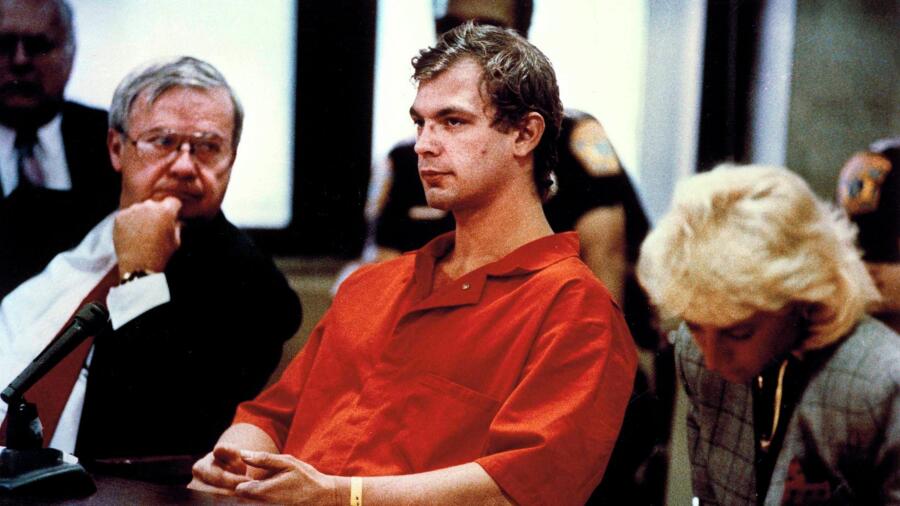
On July 22, 1991, Tracy Edwards managed to escape from the Milwaukee, Wisconsin apartment where he had been held captive by a man who had handcuffed and threatened him. Following his encounter with Edwards, law enforcement officers were alerted and proceeded to investigate the apartment in question. It was there that they came face to face with Jeffrey Dahmer, and what they discovered within his apartment sent shockwaves through the nation.
Inside Dahmer's residence, authorities unearthed a gruesome scene: human remains, including severed heads, scattered throughout the premises. Dahmer swiftly confessed to the unimaginable horror, admitting to a staggering total of 17 murders. His macabre spree allegedly began when he was just 18 years old, with 16 more victims falling prey to his depravity between 1987 and 1991.
As the evidence mounted, police validated Dahmer's chilling confessions, ensuring his incarceration pending trial. However, the legal proceedings that followed would not solely focus on determining his guilt or innocence. Instead, the trial would grapple with a more complex question: was Dahmer driven by insanity, or did he commit these abhorrent acts as a fully aware and rational individual?
Dahmer Changed His Plea
Dahmer's legal saga took a dramatic turn when, on September 10, 1991, he initially pleaded not guilty to 15 charges of murder. However, complicating matters, his first known victim, Steven Hicks, was murdered in Ohio, leading Dahmer to potentially face charges in that state as well. Furthermore, prosecutors in Wisconsin chose not to press charges for his second claimed victim, as the body had not been recovered.
However, the narrative shifted once again on January 13, 1992, as Dahmer made a startling decision: he changed his plea to guilty but insane. This pivotal move effectively bypassed the need for a conventional criminal trial, redirecting the focus to Dahmer's mental state. In a departure from standard legal procedure, the jury's decision regarding Dahmer's sanity would not require a unanimous verdict. Rather, only 10 out of 12 jurors needed to concur on Dahmer's mental condition for the verdict to hold.
Brian Hobson, a legal expert, shed light on Wisconsin's unique approach to insanity proceedings. Unlike many other jurisdictions, Wisconsin employs a bifurcated process for insanity trials. The first phase addresses the defendant's culpability for the crime, requiring a unanimous verdict. If found guilty, the proceedings then transition to the insanity phase, where a different standard applies: a verdict of insanity necessitates agreement from 10 out of the 12 jurors.
Hobson further elaborated on Wisconsin's criteria for insanity, emphasizing that a defendant may be deemed insane if, at the time of the incident, they either lacked the substantial capacity to comprehend the wrongfulness of their actions or were unable to conform their behavior to the law's requirements due to an underlying mental illness or defect. This nuanced approach underscores the intricate legal considerations at play in Dahmer's case.
At The Courthouse
As Dahmer's trial commenced on January 30, 1992, the Milwaukee County Courthouse became a focal point of intense public interest.Robyn Maharaj, co-author of "Grilling Dahmer" alongside Detective Patrick Kennedy, who had interrogated Dahmer, recalls the scene vividly. Media outlets, driven by the burgeoning 24-hour news cycle of the early '90s, swarmed the courthouse, eager to cover every detail of the sensational serial killer trial. Crowds gathered outside, clamoring for seats or any vantage point close to the courtroom.
The trial's proceedings reignited local wounds, particularly concerning the tragic case of 14-year-old Konerak Sinthasomphone. His escape from Dahmer's clutches on May 27, 1991, only to be returned to his captor by authorities who failed to recognize the danger, underscored the systemic failures that allowed Dahmer's crimes to persist. The mishandling of this incident, along with broader issues of police negligence towards communities of color and LGBTQ+ individuals, fueled public outrage and further intensified the scrutiny on the trial.
Inside the courtroom, tensions ran high, as described in Maharaj and Kennedy's book. An imposing 8-foot bulletproof glass barrier separated spectators from the courtroom, underscoring the gravity of the proceedings. Security measures were stringent, with thorough sweeps for explosives conducted before each session. Seats were reserved not only for the families of Dahmer's victims but also for his own father and stepmother, reflecting the deeply personal and emotionally charged nature of the trial.
The Dahmer Trial Begins
As the Dahmer trial commenced, the central question revolved around his ability to control his actions. Psychologist Dr. Holly Schiff, highlighted Dahmer's admission of knowing the wrongfulness of his actions, shifting the focus to whether he possessed the capacity to restrain himself. By opting for an insanity plea, Dahmer assumed the burden of proving to the jurors, 10 of whom needed to agree, that he was indeed insane at the time of the murders.
In his opening statement, Dahmer's defense attorney, Gerald Boyle, portrayed his client not as inherently evil but as deeply troubled. Boyle acknowledged Dahmer's grisly acts of necrophilia, cannibalism, and lobotomies, attributing them to Dahmer's affliction with necrophilia, a psychological disorder characterized by a desire for sexual contact with corpses.
Boyle emphasized Dahmer's warped desire to create "zombies," individuals who would be perpetually available to him. He also pointed to Dahmer's fixation on the Emperor character from "Return of the Jedi," noting his client's attempt to emulate the character with yellow contact lenses.
However,Prosecutor E. Michael McCanncountered Boyle's portrayal, highlighting Dahmer's demonstrated ability to exert control over his behavior. McCann pointed out Dahmer's methodical approach in selecting victims and the carefully controlled environment in which he carried out his killings.
In chilling detail, the court heard of Dahmer's modus operandi. He enticed potential victims to his apartment under false pretenses, promising sex or money in exchange for photos. Once inside, he drugged them before carrying out his heinous acts. Dahmer often documented the gruesome process with photographs, some victims were even lobotomized while still alive. In addition to engaging in necrophilia, Dahmer kept body parts as trophies and for cannibalistic purposes, painting a horrifying picture of his depravity.
Sane Or Insane?
Throughout Dahmer's trial, a significant portion was dedicated to testimony from psychologists and psychiatrists regarding his mental state. Defense witnesses characterized Dahmer's behavior as indicative of mental illness. Dr. Judith V. Becker, diagnosing Dahmer as a necrophiliac, emphasized that his actions stemmed from a mental disease. Dr. Carl Wahlstrom considered Dahmer's ambition to construct a temple from collected skulls as potentially delusional and psychotic. Dr. Fred S. Berlin echoed this sentiment, asserting that Dahmer's behavior undeniably reflected mental illness.
In contrast, experts for the prosecution depicted Dahmer as a calculated killer in control of his actions. Dr. Frederick Fosdal, testifying for the prosecution, recalled Dahmer admitting to having choices and making deliberate ones. Dr. Park Elliott Dietz noted Dahmer's meticulous planning and use of condoms to avoid contracting AIDS, highlighting the intentional nature of his crimes.
During closing arguments on February 14, 1992, Dahmer's defense attorney, Boyle, described his client as a "runaway train on a track of madness," implying that Dahmer was so impaired that he couldn't stop his killing spree. Conversely, Prosecutor McCann used photos of Dahmer's victims to urge the jury not to be deceived by Dahmer's facade, imploring them not to let him fool them.
Ultimately, the jury deliberated whether Dahmer's actions stemmed from mental illness and rendered him unable to conform to the law. Despite the defense's assertions, 10 out of 12 jurors found Dahmer not mentally ill. As a result, his ability to control himself was not legally considered.
The Verdict In Dahmer’s Trial
The jury's deliberations in Dahmer's trial revolved around assessing whether he suffered from a mental illness that rendered him incapable of conforming to the law. If deemed sane, Dahmer would face imprisonment, but if declared insane and unable to control his actions, he would be sent to a state institution with the possibility of later petitioning for release.
Ultimately, on February 15, 1992, 10 out of 12 jurors determined that Dahmer was not mentally ill. Consequently, since he was not found to be insane, the question of his ability to control himself did not require a decision. Dr. Schiff, reflecting on the verdict, emphasized the meticulous planning and organization evident in Dahmer's crimes.
His actions, she argued, were marked by a high degree of premeditation and careful victim selection. For instance, Dahmer deliberately targeted individuals without cars to minimize the risk of being traced through missing vehicle reports. Dr. Schiff contended that such calculated behavior contradicts the typical characteristics of insanity, as it demonstrates advanced planning and forethought not typically associated with mental illness.
What Was Dahmer’s Sentence?
Following the verdict, Dahmer had the opportunity to address the court, a moment that brought a hushed silence to the proceedings as many listened intently to his words for the first time. Dahmer expressed a desire to understand the root cause of his actions, attributing them to an acknowledged sickness. He indicated that learning about his condition from medical professionals had brought him some sense of peace.
Subsequently, Judge Laurence C. Gram handed down a sentence of 15 consecutive life terms to Dahmer. However, Dahmer's legal woes were not yet over. He faced another trial for a separate murder in Ohio, where he was found guilty and received yet another life sentence.
Tragically, on November 28, 1994, Dahmer met a violent end at Wisconsin's Columbia Correctional Institution. He was beaten to death by a fellow inmate, Christopher Scarver, who claimed that Dahmer had been provocatively flaunting his cannibalistic tendencies to other prisoners. This brutal incident marked the final chapter in Dahmer's tumultuous and horrifying saga.
See Also:
